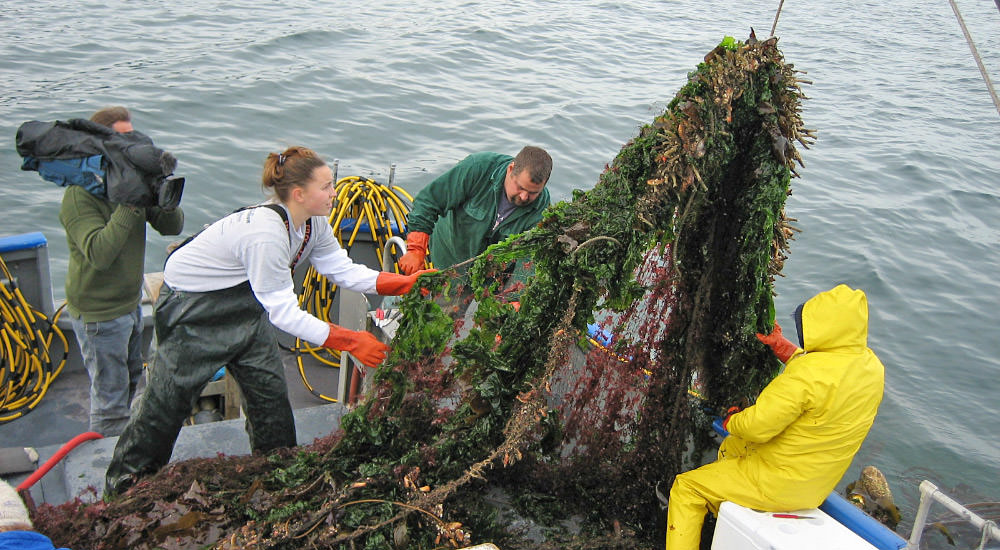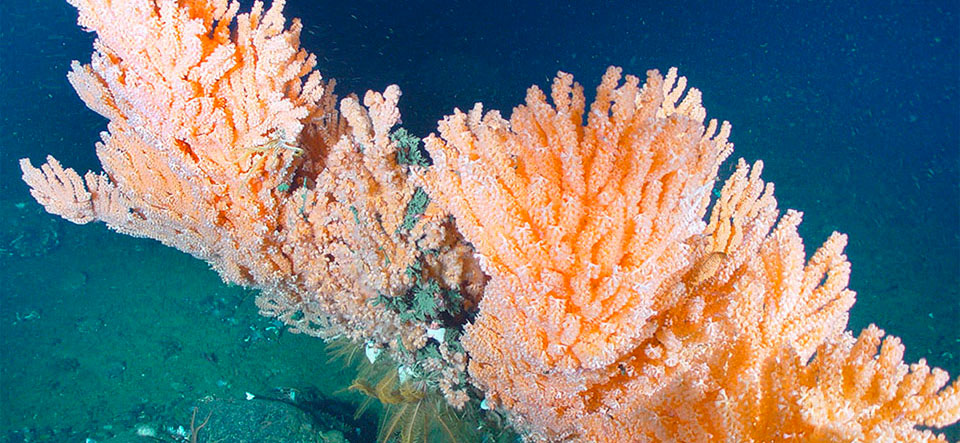Fishing Impacts
Olympic Coast

Why is it a concern?
Commercial and recreational fishing are vital elements of Washington's coastal social structure and economy that provide employment, recreation and food resources to the region and beyond. Fishing occurs within the sanctuary and is managed by federal, tribal and state authorities. Commercial, subsistence and recreational fishers are vested in the health and sustainability of these ocean fisheries. However, some aspects of fishing practices have potential to deplete targeted and non-targeted stocks or to negatively impact habitats and ecosystem functions. In recent years, NOAA's Fisheries Service has implemented regulations on the West Coast to restore stocks of overfished species and has moved toward more sustainable, ecosystem-based fishery management, including bottom trawl gear requirements that restrict the practice to areas with less habitat complexity and limited area closures to reduce physical damage to Essential Fish Habitat, or locations with habitat essential for fish spawning, breeding, feeding and growth to maturity.
Bottom contact fishing gear of various types can cause physical damage to living and archaeological resources and reduce the structural complexity of seafloor habitats. Fragile and slow growing coral and sponge communities can be damaged by a single pass of a trawl net or severed by ropes on fixed fishing gear, and the biogenic habitats may take many years to recover in the absence of further disturbance. Sanctuary scientists have led exploratory surveys to document the distribution of deep coral and sponge communities off Washington state, but data are limited , as is knowledge of the nature and extent of impacts to seafloor habitats.
Rough waters, mobile seafloor sediments and complex seabed features within the sanctuary increase the potential for fishing gear loss, particularly crab pots. Derelict fishing gear can degrade spawning and rearing grounds, kill marine life, threaten human safety, and diminish the aesthetic qualities for activities such as scuba diving. Abandoned gear can persist for many years. The phrase “ghost fishing” applies to the phenomenon where derelict gear continues to attract, trap and kill a wide variety of marine mammals, seabirds, shellfish and other invertebrates, and fish. A direct economic impact of ghost fishing is the reduction of fishery stocks otherwise available for commercial and recreational fishers. In 2006, sanctuary scientists initiated surveys for derelict fishing gear and support ongoing state and tribal collaborations to locate and remove derelict crab gear.
Overview of Research
Olympic Coast National Marine Sanctuary is actively seeking research partners to conduct work connected to Fishing Impacts as a sentinel issue.
| Project Name | PI and contacts | Links |
|---|---|---|
Deep coral and sponge assemblages and distribution |
Ed Bowlby and Mary Sue Brancato, OCNMS; Jeff Hyland, NCCOS |
http://sanctuaries.noaa.gov/science/conservation/bowlby.html |
Fish-habitat associations |
Katie Wrubel, Washington State University MS Thesis |
|
Visual Fish Surveys in sub tidal habitats |
Reef Environmental Education Foundation |
|
Survey and Removal of derelict fishing gear |
OCNMS and the Makah Tribe |
http://olympiccoast.noaa.gov/protect/marinedebris/derelictgear.html www.derelictgear.org (Puget Sound) |
Derelict crab gear removal |
Washington Department of Fish and Wildlife |
Science Needs and Questions
The best available science is used by sanctuary scientists and managers working to address priority resource conservation and management issues. As priorities change and new issues emerge, each sanctuary develops new science needs and questions and works with partners to address them.
- What suite of environmental characteristics contributes to marine habitats that are essential for survival of various fish species or guilds?
- What is the distribution and abundance of deep-sea corals and sponges, in areas not yet explored with underwater imaging technology? What is the age structure of these communities and what are their recruitment patterns?
- Do the biogenic structures of deep corals and sponges constitute unique ecological communities? What ecological linkages exist between deep coral and sponge biogenic assemblages and other habitats in the Sanctuary?
- What is the resilience of deep corals and sponges to other anthropogenic impacts such as increased ocean temperature and ocean acidification?
- What aspects of fishing practices and management contribute to non-sustainable trends in fishery stocks?
Education and Outreach Material
National Marine Sanctuary Sustainable Seafood Lesson Plan
National Marine Fisheries Service - Sustainable U.S. Seafood
National Marine Fisheries Service - Elementary curriculum on Killer Whales
National Marine Fisheries Service - Salmon Activities
National Geographic - Sushi Bar: You, Me, Sushi

References
Bowlby, C.E., M.S. Brancato, J. Bright, K. Brenkman, and J. Boutillier. 2011. A Characterization of Deep-Sea Coral and Sponge Communities on the Continental Shelf of Northern Washington, Olympic Coast National Marine Sanctuary, Using a Remotely Operated Vehicle in 2008. December 1, 2011. A Preliminary Report to the Pacific Fishery Management Council Essential Fish Habitat Review Committee.
Bowlby, C.E., M.S. Brancato, J. Bright, K. Brenkman, and J. Hyland. 2011. A Characterization of Deep-Sea Coral and Sponge Communities on the Continental Shelf of Northern Washington, Olympic Coast National Marine Sanctuary, Using a Remotely Operated Vehicle in 2006. December 1, 2011. A Preliminary Report to the Pacific Fishery Management Council Essential Fish Habitat Review Committee.
Brancato, M.S., C.E. Bowlby, J. Hyland, S.S. Intelmann, and K. Brenkman. 2007. Observations
of Deep Coral and Sponge Assemblages in Olympic Coast National Marine Sanctuary, Washington. Cruise Report: NOAA Ship McArthur II Cruise AR06-06/07. Marine Sanctuaries Conservation Series NMSP-07-03. U.S. Department of Commerce, National Oceanic and Atmospheric Administration, National Marine Sanctuary Program, Silver Spring, MD. 48 pp.
Morgan, L.E., P. Etnoyer, A.J. Scholz, M. Mertens, and M. Powell. 2005. Conservation and
management implication of deep-sea coral and fishing effort distributions in the Northeast Pacific Ocean. In A. Freiwald and J. Roberts (eds), pp. 1171-1187. Cold-water Corals and Ecosystems. Springer-Verlag, Berlin Heidelberg.
Morgan, L.E., F. Tsao, and J.M. Guinotte. 2006. Status of deep sea corals in US waters, with recommendations for their conservation and management. Marine Conservation Biology Institute, Bellevue, WA
NRC, Inc. (Natural Resources Consultants, Inc.). 2008. Rates of marine species mortality caused by derelict fishing nets in Puget Sound, Washington. Prepared for Northwest Straits Initiative. May 15, 2009. 14pp.
Office of National Marine Sanctuaries. 2008. Olympic Coast National Marine Sanctuary Condition Report 2008. U.S. Department of Commerce, National Oceanic and Atmospheric Administration, Office of National Marine Sanctuaries, Silver Spring, MD. 42 pp.

